1993 CHEVROLET LUMINA headlights
[x] Cancel search: headlightsPage 47 of 324
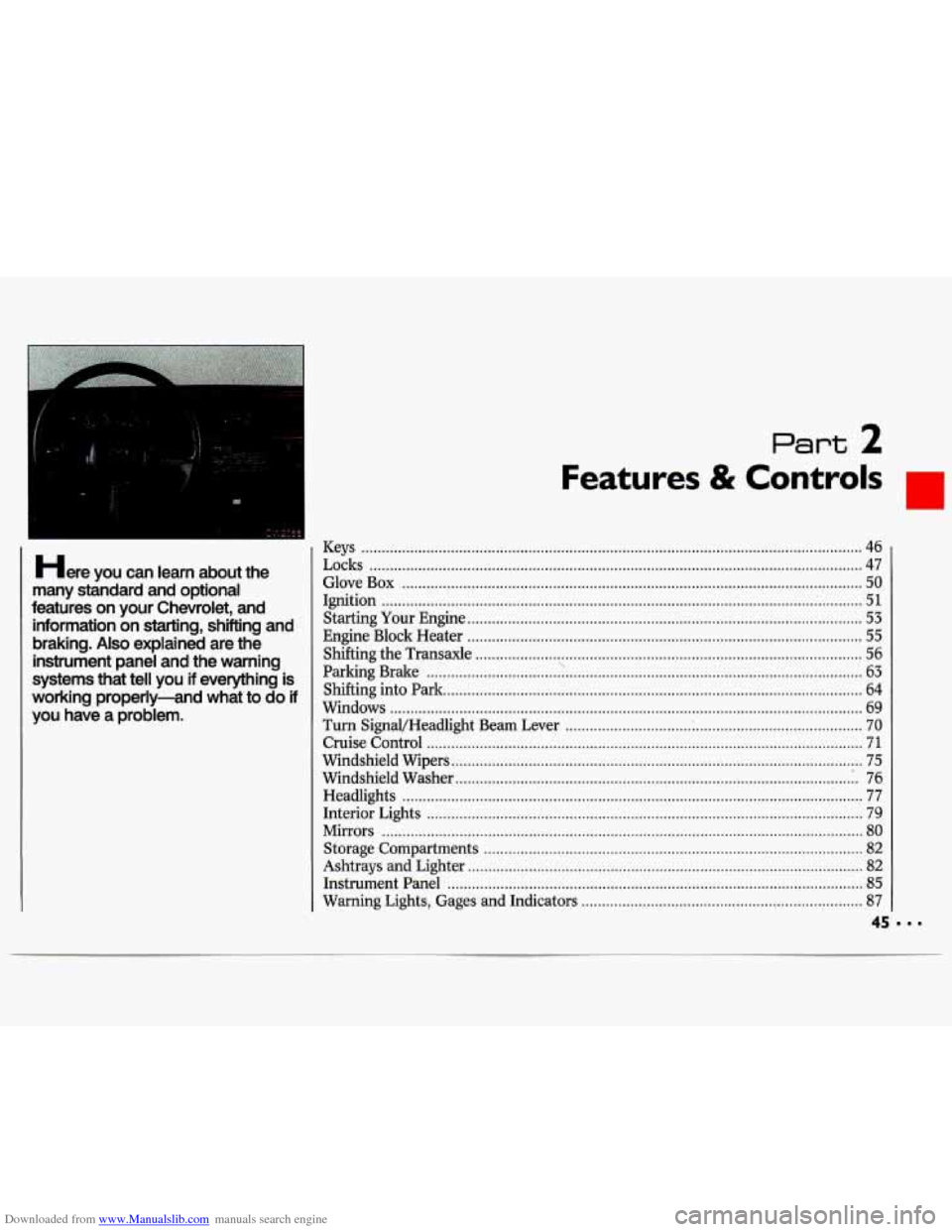
Downloaded from www.Manualslib.com manuals search engine Here you can learn about the
many standard and optional
features on your Chevrolet. and information
on starting. shifting and
braking
. Also explained are the
instrument panel and the warning
systems that tell you if everything is
working properly+ nd what to
do if
you have a problem .
Part 2
Features & Controls .
Keys ........................................................................\
................................................... 46
Locks
........................................................................\
................................................. 47
Glove Box
........................................................................\
......................................... 50
Ignition
........................................................................\
.............................................. 51
Starting Your Engine
........................................................................\
......................... 53
Engine Block Heater
........................................................................\
......................... 55
Shifting the Transaxle
........................................................................\
....................... 56
Parking Brake ........................................................................\
................................... 63
Shifting into Park
........................................................................\
............................... 64
Windows
........................................................................\
............................................ 69
Turn SignaVHeadlight Beam Lever ............................... : ......................................... 70
Cruise Control ........................................................................\
................................... 71
Windshield Wipers ........................................................................\
............................. 75
Windshield Washer
........................................................................\
........................... 76
Headlights
........................................................................\
......................................... 77
Interior Lights ........................................................................\
................................... 79
Mirrors ........................................................................\
.............................................. 80
Storage Compartments
........................................................................\
..................... 82
Ashtrays and Lighter
........................................................................\
......................... 82
Instrument Panel
........................................................................\
.............................. 85
Warning Lights, Gages and Indicators
..................................................................... 87
...
Page 79 of 324

Downloaded from www.Manualslib.com manuals search engine Headlights
The main light controls are on the left
side of the instrument panel. Push the
switch marked
pf to turn on your:
Parking Lights
Side Marker Lights
Taillights
License Plate Lights
Instrument Panel Lights
Push the switch again to turn them off. Push
the switch marked
-g- to turn on
your headlights, together with your:
Parking Lights
Side Marker Lights
Taillights
License Plate Lights
Instrument Panel Lights
Push the switch again to turn them off.
Operation of Lights
Although your vehicle’s lighting system
(headlamps, parking lamps, fog lamps,
side marker lamps and tail lamps) meets
all applicable federal lighting
requirements, certain states and
provinces may apply their
own lighting
regulations that may require special
attention before
you operate these
lamps. For example, some jurisdictions
may require that you operate your lower
beam lamps with fog lamps
at all times,
or that headlamps be turned on
whenever you must use your windshield
wipers. In addition, most jurisdictions
prohibit drively solely with parking
lamps, especially at dawn or
dusk. It is
recommended that you check with your
own state or provincial highway
authority for applicable lighting
regulations.
Lights On Reminder
If you open the door with the ignition
off and the lights on, you will hear
a
warning chime.
Page 80 of 324

Downloaded from www.Manualslib.com manuals search engine Features & Controls
Daytime Running Lights
(CANADA ONLY)
The Canadian Federal Government has decided that
Daytime Running Lights
(DRL) are a useful feature, in that DRL
can make your vehicle more visible to
pedestrians and other drivers during daylight hours. DRL are required
on
new vehicles sold in Canada.
Your DRL work with a light sensor on
top
of the instrument panel. Don’t
cover it up.
The low beam headlights will come
on
at reduced brightness in daylight when:
The ignition is on
The headlight switch is off, and
The parking brake is released. At dusk,
the exterior lights will come on
automatically and the low beams will
change to full brightness. At dawn, the
exterior lights will go out and the low
beams will change to the reduced
brightness of DRL (if the headlight
switch is
off).
Of course, you may still turn on the
headlights any time you need to.
To idle your vehicle with the
DRL off,
set the parking brake while the ignition
is in the
Off or Lock position. Then
start the vehicle. The DRL will stay
off
until you release the parking brake.
L I
c
Headlight High-Low Beam
Changer
I
To change the headlights from low
beam to high
or high to low, pull the
turn signal lever all the way toward you.
I
Then release it.
When the high beams are
on, a blue
light on the instrument panel also will
be on.
78
Page 81 of 324
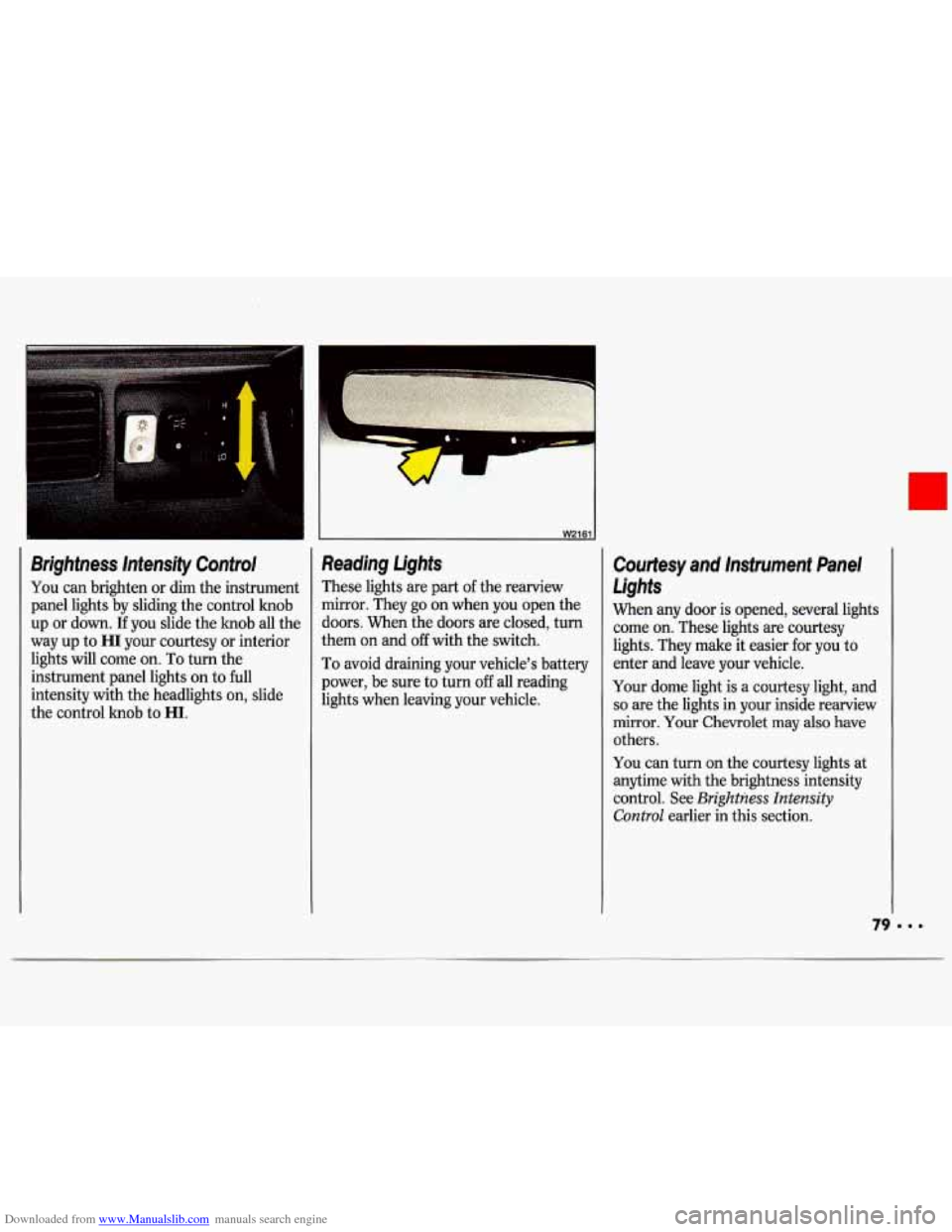
Downloaded from www.Manualslib.com manuals search engine I
I I
‘I W2161
Brightness Intensify Control
You m brighten or dim the instrument
panel lights by sliding the control knob
up or down.
If you slide the knob all the
way up to
HI your courtesy or interior
lights will come on. To turn the
instrument panel lights on to full
intensity with the headlights on, slide
the control knob to
HI.
I
Reading Lights
These lights are part of the rearview
mirror. They go on when you open the
doors. When the doors are closed, turn
them on and
off with the switch.
To avoid draining your vehicle’s battery
power, be sure to turn
off all reading
lights when leaving your vehicle.
Courtesy and Instrument Panel
Lights
When any door is opened, several lights
come on. These lights are courtesy
lights. They make it easier for you to
enter and leave your vehicle.
Your dome light is a courtesy light, and
so are the lights in your inside rearview
mirror. Your Chevrolet may also have
others.
You can turn on the courtesy lights at
anytime with the brightness intensity
control. See
Brightness Intensity
Control earlier in this section.
Page 139 of 324
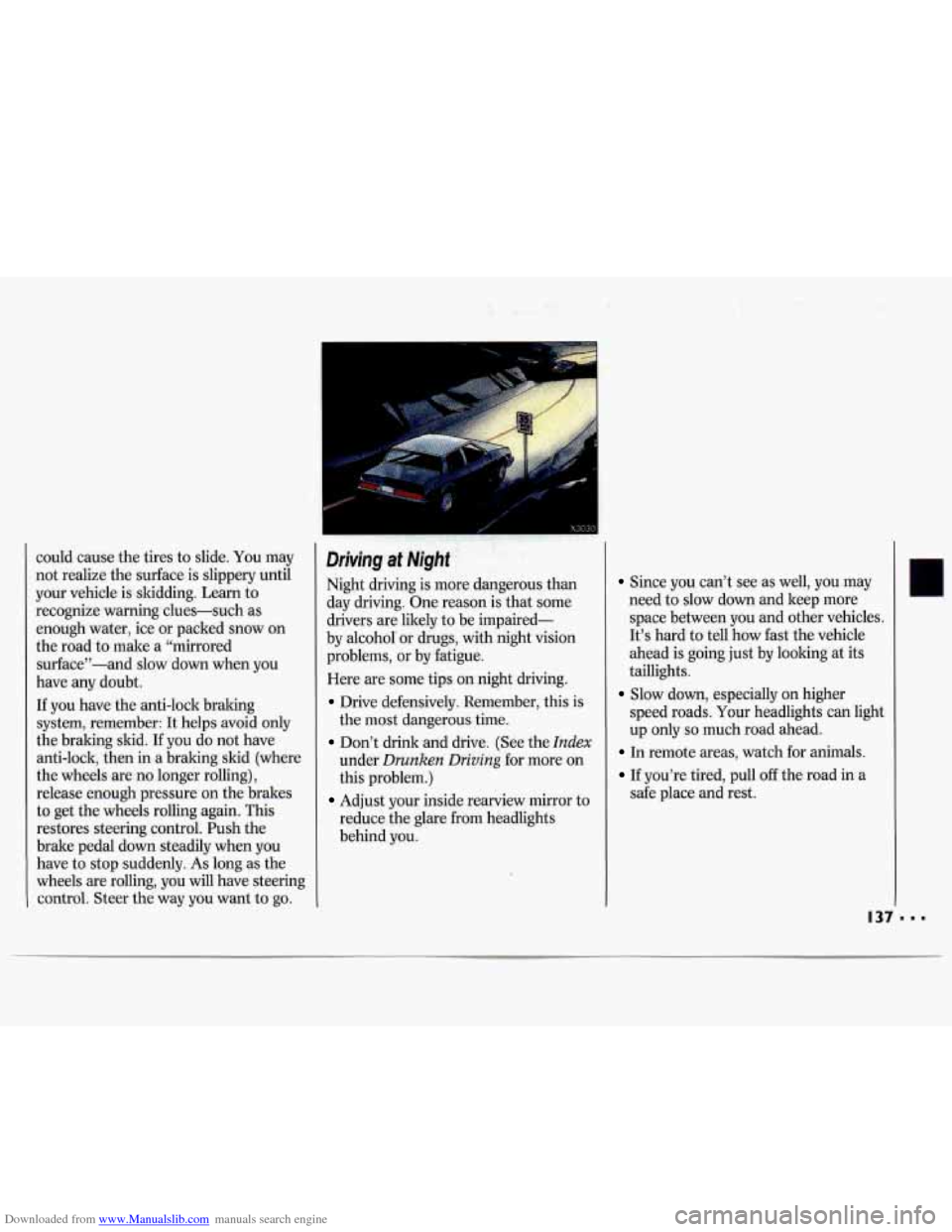
Downloaded from www.Manualslib.com manuals search engine -.,.. -
could cause the tires to slide. You may
not realize the surface is slippery until
your vehicle is skidding. Learn to
recognize warning clues-such as
enough water, ice or packed snow on
the road to make a “mirrored
surface”-and slow down when you
have any doubt.
If you have the anti-lock braking
system, remember: It helps avoid only
the braking
skid. If you do not have
anti-lock, then
in a braking skid (where
the wheels are no longer rohg),
release enough pressure on the brakes
to get the wheels rolling again.
This
restores steering control. Push the
brake pedal down steadily when
you
have to stop suddenly. As long as the
wheels are rolling, you will have steering
control. Steer the way you want to
go.
-
X3030 , , -;. - ., ,
Driving. at Might
Night driving is more dangerous than
day driving. One reason is that some
drivers are likely to be impaired-
by alcohol or drugs, with night vision
problems,
or by fatigue.
Here are some tips on night driving.
Drive defensively. Remember, this is
the most dangerous time.
Don’t drink and drive. (See the Index
under Drunken Driving for more on
this problem.)
Adjust your inside rearview mirror to
reduce the glare from headlights
behind you.
Since you can’t see as well, you may
need to slow
down and keep more
space between you
and other vehicles.
It’s hard to tell how fast the vehicle
ahead’is going just by looking at its
taillights.
Slow down, esp.ecially on higher
speed roads. Your headlights can light
up only so much road ahead.
In remote areas, watch for animals.
If you’re tired, pull off the road in a
safe place and rest.
Page 140 of 324
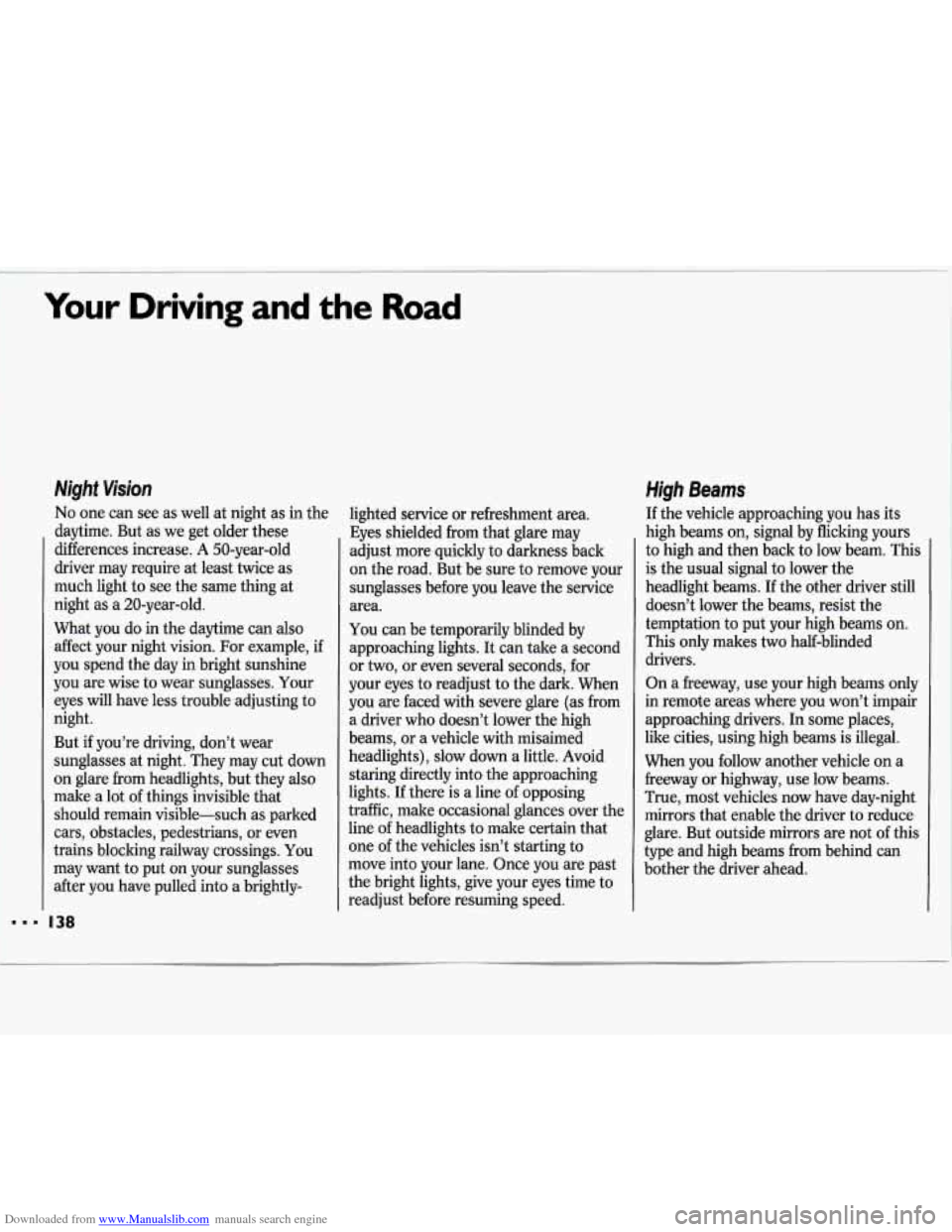
Downloaded from www.Manualslib.com manuals search engine I
Your Driving and the Road
Night Vision
No one can see as well at night as in the
daytime. But as we get older these
differences increase.
A 50-year-old
driver may require at least twice as
much light to see the same thing at
night as a 20-year-old.
What you do in the daytime can also
affect your night vision. For example,
if
you spend the day in bright sunshine
you are wise to wear sunglasses. Your
eyes will have
less trouble adjusting to
night.
But
if you’re driving, don’t wear
sunglasses at night. They may cut down
on glare from headlights, but they also
make a lot
of things invisible that
should remain visible-such as parked
cars, obstacles, pedestrians, or even
trains blocking railway crossings.
You
may want to put on your sunglasses
after you have pulled into a brightly-
I38
lighted service or refreshment area.
Eyes shielded from that glare may
adjust more quickly to darkness back
on the road. But be sure to remove your
sunglasses before you leave the service
area.
You can be temporarily blinded by
approaching lights. It can tale a second
or two, or even several seconds, for
your eyes to readjust to the dark. When
you are faced with severe glare (as from
a driver who doesn’t lower the high
beams, or a vehicle with misaimed
headlights), slow down a little. Avoid
staring directly into the approaching
lights. If there is a line
of opposing
traffic, make occasional glances over the
line of headlights to make certain that
one of the vehicles isn’t starting to
move into your lane. Once you are past
the bright lights, give your eyes time to
readjust before resuming speed.
High Beams
If the vehicle approaching you has its
high beams on, signal by flicking yours
to high and then back to low beam. This
is the usual signal to lower the
headlight beams. If the other driver still
doesn’t lower the beams, resist the
temptation to put your high beams on.
This
only makes two half-blinded
drivers.
On a freeway, use your high beams only
in remote areas where you won’t impair
approaching drivers.
In some places,
like cities, using high beams is illegal.
When you follow another vehicle on a
freeway or highway, use low beams.
True, most vehicles now have day-night
mirrors that enable the driver to reduce
glare. But outside mirrors are not
of this
type and high beams from behind can
bother the driver ahead.
Page 141 of 324

Downloaded from www.Manualslib.com manuals search engine Remember that your headlights light up
far less of
a roadway when you are in a
turn or curve.
Keep your eyes moving; that way, it’s
easier to pick out dimly li@ted objects.
Just as
your headlights should be
checked regularly for proper aim,
so
should your eyes be examined regularly. Some drivers suffer
from night
blindness-the inability to see in dim
light-and aren’t even aware
of it. Rain and
wet roads can mean driving
trouble.
Qn a wet road.you can’t stop,
accelerate or turn
as well because your
tire-to-road traction isn’t as good
as on
dry roads. And, ifyour tires don’t have
much tread lea, you’ll get even less
traction.
It’s always wise to go slower and be
cautious
if rain starts to fall while you
are driving. The surface may get wet
suddenly when your reflexes are tuned
for driving on dry pavement.
The heavier the rain, the harder it is to
see. Even
if your windshield wiper
blades are in good shape, a heavy rain
can make it harder to
see road signs and
traffic signals, pavement markings, the
edge of the road, and even people
Page 143 of 324
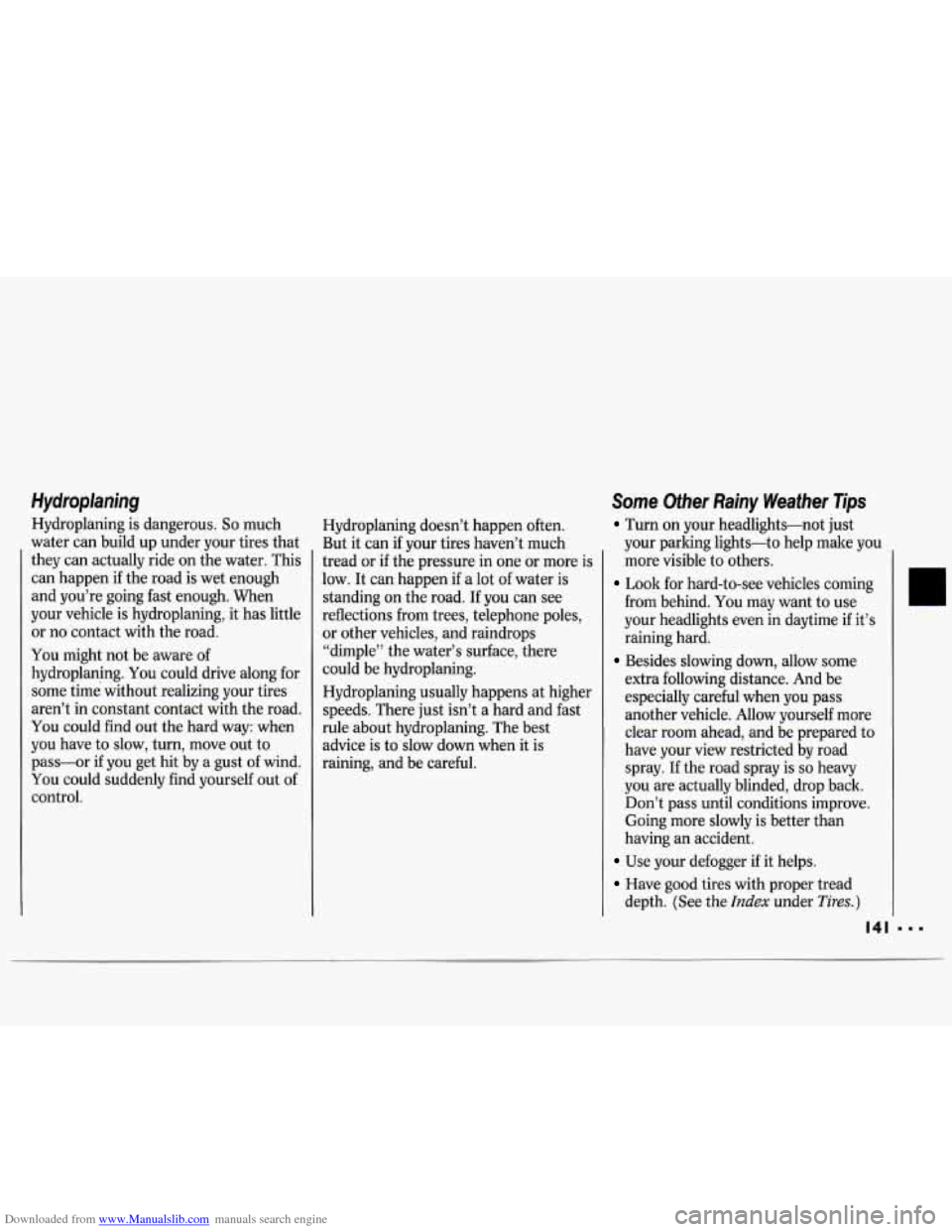
Downloaded from www.Manualslib.com manuals search engine Hydroplaning
Hydroplaning is dangerous. So much
water can build up under your tires that
they can actually ride on the water. This
can happen if the road is wet enough
and you’re going fast enough. When
your vehicle is hydroplaning, it has little
or no contact with the road.
You might not be aware of
hydroplaning.
You could drive along for
some time without realizing your tires
aren’t in constant contact with the road.
You could find out the hard way: when
you have to slow, turn, move out to
pass--or if you get hit by
a gust of wind.
You could suddenly find yourself out of
control. Hydroplaning doesn’t happen often.
But
it can
if your tires haven’t much
tread or if the pressure in one or more is
low. It can happen if a lot of water is
standing on the road. If you can see
reflections from trees, telephone poles, or other vehicles, and raindrops
“dimple” the water’s surface, there
could be hydroplaning.
Hydroplaning usually happens at higher
speeds. There just isn’t a hard and fast
rule about hydroplaning. The best
advice is to slow down when it
is
raining, and be careful.
Some Other Rainy Weather Tips
Turn on your headlights-not just
your parking lights-to help make you
more visible to others.
Look for hard-to-see vehicles coming
from behind.
You may want to use
your headlights even in daytime if it’s
raining hard.
Besides slowing down, allow some
extra following distance. And be
especially careful when you pass
another vehicle. Allow yourself more
clear room ahead, and be prepared to
have your view restricted by road
spray. If the road spray is
so heavy
you are actually blinded, drop back.
Don’t pass until conditions improve.
Going more slowly is better than
having an accident.
Use your defogger if it helps.
Have good tires with proper tread
depth. (See the
Index under Tires.)